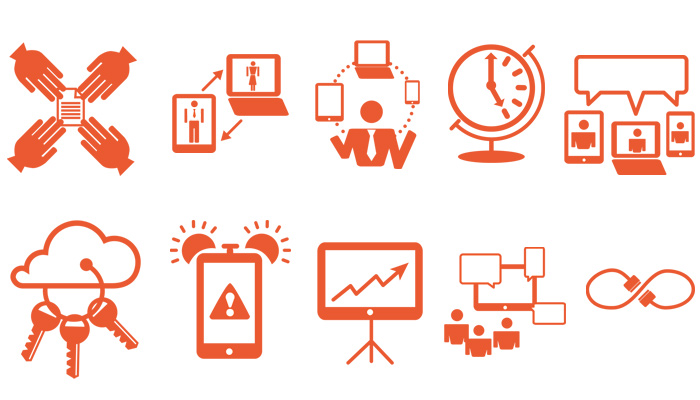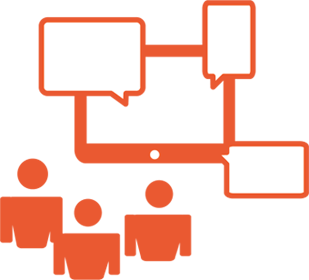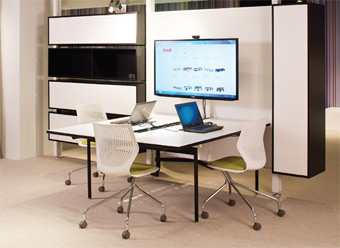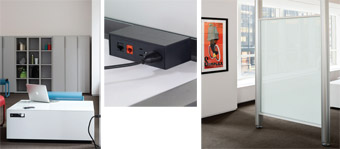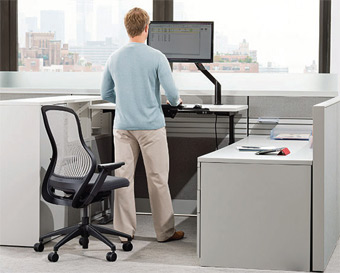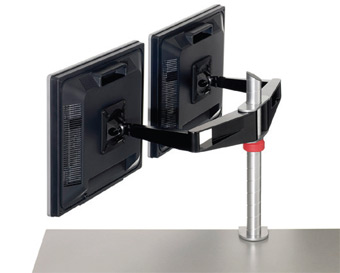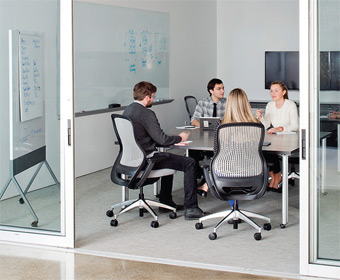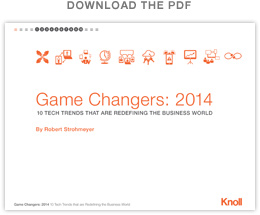
By Robert Strohmeyer
“There is nothing permanent except change.”
-HERACLITUS
Move over, corner offices and cube farms. The face of the workplace is changing more rapidly than ever, and if you think the tech revolution has shaken things up so far, you’re in for a serious jolt. We’re not just talking new gadgets, either. As emerging technologies transform the way we collaborate, communicate, and compute, the underlying nature of what we call work – let alone what we call an office – is taking on surprising new dimensions.
The transition from the paper-based office to the digital office may end up looking like a subtle shift compared with the changes the latest technology trends have in store. Screen-sharing and virtual meetings, mobile-first apps, and cloud computing have matured into powerful business tools that could demand new ways of thinking about what it means to go to work.
Executive Summary:
> Virtual collaboration tools, software-based whiteboards, democratized teleconferencing solutions, and ubiquitous mobile devices will enable more flexible office designs.
> Increasingly mobile and constantly connected workforces will make time-shifting a business advantage.
> Personal cloud apps and mobile devices serving as second screens will require more versatile workstations.
> The Internet of Everything—in which traditionally “dumb” devices join the network and emit actionable data—will enable deeper business intelligence while demanding more robust network infrastructure.
Here are ten intensely interesting new technologies
that are changing the face of office life.
1 Virtual Sharing & Document Collaboration
With the birth of cloud computing, and in particular apps like Google Docs and Microsoft’s new Office 365, the concept of sharing has suddenly changed. The ability to share and edit documents collaboratively in real time doesn’t just save time; it changes the entire creative process. As you and your colleagues work together, you can see each others changes as they happen, make comments to each other live, and track every change as you go. One person can lay out an outline and formatting while another fills in the content, and a third can proofread as they go.
Meanwhile, desktop-sharing with tools such as JoinMe, Microsoft’s Windows Remote Desktop, and Apple’s Messages desktop app allow workers to see each other’s entire work areas in real time, enhancing transparency and adding visual experience to long-distance collaboration. In the office, document collaboration is gaining popularity even for in-person meetings, allowing everyone at the conference table to work on the same project together. In this new collaborative world, conference rooms are less essential, and any surface can become a conference table.


2 Mobile-First Workflow
By the close of 2013, sales of desktop computer sales slumped to record lows as laptop and tablet sales continued to soar, and tech companies sold more tablets than desktop PCs for the first time in history. Meanwhile, people spent more time on mobile devices than desktop and laptops in 2013, and that shift shows no signs of slowing in the foreseeable future. Mobile app sales racked up some $26 billion in sales worldwide last year, prompting software creators to embrace mobile devices as the primary point of contact for most users.
While most of the mobile trend has focused on consumer technology to date, business applications are getting increasingly mobile-centric in 2014. Even Micrososft Office 365, the flagship of all business suites and perhaps the best indicator of where the corporate mainstream is headed, is now optimized for use on iPhones and Android devices.
Mobile-first workers no longer require (some even abhor) a permanent desk. At Intel, for instance, many workers – even relatively senior staffers – no longer require their own permanent desks, and instead drop their laptops on one of a number of flexible workspaces on the days when they work in the office. The arrangement lets the company use its space more efficiently, while giving workers the freedom to work from anywhere.
3 The Second Screen
Everywhere we go, smartphones and tablets are supplementing the work experience as we divide our attention between the software on our laptops and the apps on our mobile devices. It’s often an intuitive split that takes the best aspects of computer-based and mobile productivity and blends them into a single experience. It’s now common to see a colleague working busily on their laptop to build a presentation, and then pause momentarily to read a text message on their smartphone about a change in the afternoon meeting agenda.
While the use of the second screen in the workplace is, so far, an ad-hoc affair, it’s evolving into a more sophisticated ecosystem of interoperable apps designed to make the most of the strengths of mobile and desktop devices in a unified way. Increasingly, workers are adding tablet stands to their workstations to enhance the multi-device experience, and this will become commonplace in the coming year.

4 Timeshifting and Asynchronous Workflow
There’s nothing especially new about globalization itself, but the advent of cloud collaboration tools is profoundly changing the way we think about teamwork, time zones, and international boundaries. While syncing up global teams can be a challenge due to difficulties in scheduling calls and meetings, there are some distinct advantages to having a team that’s distributed around the world.
The principal advantage of the global team is timeshifting—the ability to distribute workflow across timezones to keep a project progressing around the clock. A consultant in California can now spend her day gathering client feedback on a project, queue up tasks for an offshore development team in Bangalore which then passes the code to a design team in Italy, and arrive at the office the next morning to find a completed product that’s ready to present to the client. With the right distribution of talent distributed across multiple time zones, teams can now accomplish in a day or two what might take a week for a team working together in one office.
5 Personal Teleconferencing
Throughout the past decade, telepresence technologies – basically, big screens with cameras attached to them – have promised to transform the way teams collaborate across long distances by offering immersive, high-definition face-to-face meetings. While some large enterprises have invested heavily in the technology, telepresence never really went mainstream in a big way, mainly because of its expense and technical complexity. At the same time, personal teleconferencing has permeated the tech landscape as Google, Facebook, Apple, Microsoft, and nearly every other major technology company have integrated features that take advantages of the cameras built into every laptop, tablet, and smartphone.
Where professional telepresence was restrictively costly and difficult to implement, personal teleconferencing is easy and often free. As a result, it’s now commonplace to see coworkers jump on a Google Hangout or Skype session to conduct a quick meeting.

6 Personal Cloud Apps
For several years now, businesses have noticed a transformation known as the consumerization of IT. In its simplest terms, this means BYOD (bring your own device). And, as it turns out, workers have been bringing not just their own devices, but a slew of personal apps as well.
By most accounts, BYOD has already made the jump from trend to outright ubiquity. Now it remains for companies to get a handle on the myriad of personal cloud apps their workers are using to manage business data. And there’s no use fighting it: Innovation in personal mobile apps is practically unstoppable, as apps like Dropbox and Evernote build in new productivity features at a blistering pace, giving workers an ever-updating suite of new tools to manage their increasingly complex workloads.
If there was ever a time to take stock of the personal apps your teams are using in the workplace, it’s now. By implementing enterprise-class accounts on the cloud services your workers are already using, you can take better advantage of these apps’ advanced features while mitigating the risks associated with hosting your business data on accounts outside your IT department’s control.
7 Event-Driven Automation
For most of the Internet’s history, web apps have been like isolated fiefdoms, compiling users’ data in walled gardens inaccessible to outside apps. But, thanks to the growing popularity of open application programming interfaces (APIs), our favorite apps are learning to play nice with each other in increasingly useful ways. The hottest result so far: event-driven automation, which lets you automatically monitor your favorite apps and sites for specific kinds of events, and triggers useful actions when the right events take place.
The concept of event-driven automation began gaining traction with simple features like Google Alerts, which simply notifies you when a new entry matching a specific search term appears on the Web. A site called IFTTT (for “If This, Then That”) has been catching on fast with tech 1-percenters, enabling more sophisticated automation through connected web apps. You can set up triggers to do things like monitor your Gmail inbox and automatically add incoming photo attachments to a Flickr account, or track business mileage in a Google spreadsheet just by texting your latest mileage to a given number.

8 Tablet Whiteboards
Much like telepresence systems, a wave of big, pricey digital whiteboards swept into the workplace a few years ago. But, as often happens with good ideas, a better, cheaper alternative is now popping up in a far more accessible form.
Tablet-based whiteboard apps like Groupboard let you quickly kick off a whiteboard collaboration with a group, either remotely or in-person, wherever you are, bringing a newfound agility to the whiteboard experience. You can even chat with remote colleagues as you draw without requiring a separate conference session.
The upshot: It’s no longer quite as critical to have a massive whiteboard in every room, but you may want to install a few extra AirPlay-enabled monitors around your workspaces for impromptu digital collaborations. For those times when the real deal can’t be beat, mobile markerboards offer flexibility that wall-mounted whiteboards can’t match.
9 Dynamic Mobile Presentations
If you really want to convey your brilliance to a crowd, skip the usual round of fumbling with power cords and long procession of static slides. A new wave of presentation tools like Prezi, GoAnimate, and Sliderocket are making presentations interesting again with cool animations and unique approaches to the flow of information.
Get right to the point by punching a URL into any connected device and fire up your presentation on the fly, or simply whip out your iPad to showcase your work anywhere with SlideShark.

10 Internet of Everything
In a few years’ time, you may find yourself sitting around the campfire with your kids, regaling them with tales of the olden days when only computers were connected to the Internet, because in the new world, everything will be online. Known as the Internet of Everything, the coming wave of connected objects is already beginning to emerge as smart chips and wireless Internet connections are popping up in everything from smoke detectors to toothbrushes. Google’s recent $3.2B acquisition of connected-thermostat maker Nest hints at the growing importance of the trend.
In the workplace, the Internet of Everything reality will mean a massive rethinking of IT resources as every object in the office – from the vending machine in the breakroom to the paper towel dispensers in the lavatory – gets an Internet address of its own. You’ll need to beef up your network bandwidth, but in exchange you’ll gain insights never before possible, such as the ability to correlate data points between the temperature and humidity of the office and employee productivity.
About the author:
Robert Strohmeyer is a veteran business and technology journalist whose work has appeared in Wired, PCWorld, Macworld, Entrepreneur, Executive Travel, Smart Business, and numerous other publications. He tweets as @caretpi.
Considerations for planning:
These new technologies will have an indelible impact on how to plan for the office in the coming years.
Here are some key considerations as you think about how to support them:
Furniture should be a neutral platform for technology: With emerging technologies evolving at such a rapid clip, it’s essential to choose furnishings that support technology. But avoid the pitfall of selecting furnishings that re directly integrated with technology, lest you find yourself stuck with obsolete or outdated products a year or two down the line. The best furnishings are those that can adapt to new technologies easily.
A Variety of Spaces for A Variety of Workstyles: With the increase in mobile workers, people need a variety of spaces to support a broad range of work habits and activities. With open-plan offices, refuge rooms are critical for personal teleconferencing, so individuals can jump on a call or webinar with adequate privacy and minimal disruptions to co-workers. It’s also important to have spaces for impromptu meetings, and provide proper technology in conference rooms to support virtual sharing and document collaboration.
Connectivity is key: With more video content, laptops, and mobile devices than ever before, you’ll want to supply plenty of large displays in convenient locations throughout the office, enabling workers to project their screens whenever they need to share what they’re working on. The should be mounted in open spaces as well as private meeting rooms.
Be sure to consider wellness and ergonomics: While the Internet of Everything will enable organizations to track productivity metrics with more granularity than ever before, it will also empower companies to think more deeply about employee wellness through enhanced metrics. It will be important to understand how worker comfort can enhance productivity, ensuring individuals have adjustable and varied types of seating, proper lighting, monitor arms, and height adjustable tables can help support users in various postures throughout the day.
Increase productivity with multi-device experience: Research has shown an increase in productivity related to adopting a second screen, particularly as users leverage one for email and the other for work. Using a double monitor arm can help increase productivity while providing ergonomic benefits and maximizing usable desk space by lifting monitors off the work surface.
Ensure you have enough screens and mobile whiteboards: Brainstorm your next great idea with co-workers through Groupboard, or roll in a flexible whiteboard for a more tactile hands-on experience and take a picture to share the work afterward. While wall mounted whiteboards still have merit, leveraging screens and mobile whiteboards create a more agile and adaptable work environment.
DOWNLOAD "Game Changers: 2014" TO READ THE FULL PAPER
















